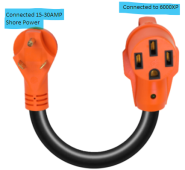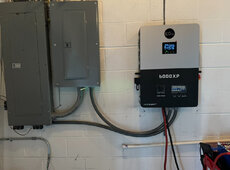I feel like I'm in the right place for asking this question. I'm going to put the 6000XP in my 50A RV.
When I'm connected to 50A shore power (120/240), everything should work as planned when connecting my L1, L2, N, and G to the XP.
However, if I pull up to a 15-30A site and use a dog-bone that takes 120V singe phase and spreads that phase between L1 and L2 (Not split phased), would that cause an issue?
The manual says it can take grid input between 120-240 volts so I messaged signature solar to inquire. Below is my question and their response...
ME: Is it theoretically safe to connect inverter to 120v Single Phase shore power (15-30amp) that is spread evenly between L1 and L2 via a Dog bone adapter. (see below)
- Of course I would disable the Ground/Neutral bond on the inverter
Signature Solar: It's not safe, we advise running it through the breaker panel, treating it like its another load. That Plug would not work for this application.
Why would this cause an issue? I need to be educated.
Thanks!
BONUS... While I'm here I might as well share the other questions I asked since I'm crossing my fingers that the answer they gave me is False. Some of the above comments in this thread support the answer that I want to hear.
ME: When the inverter is connected to shore power via a 120/240 50Amp outlet. Does the Inverter “pass thru” the full 12,000Watts if needed? (50 amps at 120V on each Leg). If so, does the output limit of 6000Watts only refers to how much total power the inverter can supply when inverting from DC to AC?
Signature Solar: Its actually 25 amps per leg for a total of 50a for both legs. 25x120=3000x2=6000w for pass through, I don't know why its phrased "Rated Output current @ 240v....25a" but i checked with two colleagues including my team lead and they confirmed its 6000w total at 3000w each leg. From DC it has a maximum of 8000w with 4000w per MPPT. Whereas AC to AC is 6000w.
Can anyone confirm the accuracy of this answer?





